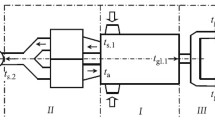A mathematical model based on the principle of the superposition of waves is proposed for the power distribution on the surface of a glass plate heated by means of tubular heaters. This model makes it possible to predict the propagation of the temperature field on the surface of glass plate as a function of the arrangement and power of the heating elements.
Similar content being viewed by others
References
O. V. Mazurin, Glass Making [in Russian], Nauka, Leningrad (1986).
J. P. Poirve, High-Temperature Deformation of Plastic Crystals [Russian translation], Metallurgiya, Moscow (1981).
O. S. Narayanaswamy, “Stress and structural relaxation in tempering glass,” J. Am. Cer. Soc., 61(3–4), 146–152 (1978).
Author information
Authors and Affiliations
Additional information
Translated from Steklo i Keramika, No. 5, pp. 30–31, May, 2009.
Rights and permissions
About this article
Cite this article
Shutov, A.I., Borovskoi, A.E. & Tatarintsev, E.S. Particularities of heating glass by a multipoint energy source. Glass Ceram 66, 183–185 (2009). https://doi.org/10.1007/s10717-009-9162-2
Published:
Issue Date:
DOI: https://doi.org/10.1007/s10717-009-9162-2




